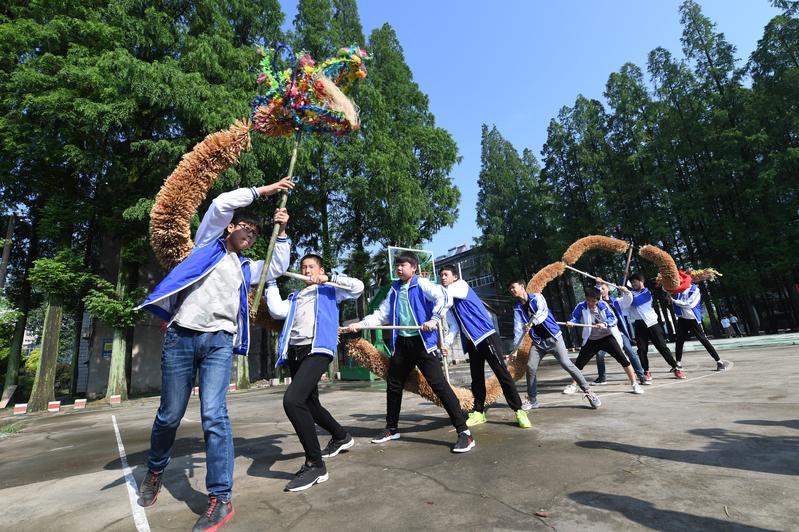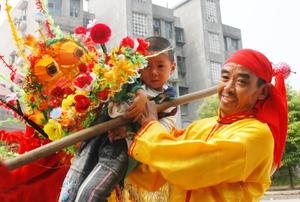Hubei province's town keeps tradition alive as festival dragon entertains in dramatic style, Xu Lin reports.
 Students from Longwan Middle School learn to perform the rice-straw dragon dance in Qianjiang's Longwan town, Hubei province. (WU YANJUN / FOR CHINA DAILY)
Students from Longwan Middle School learn to perform the rice-straw dragon dance in Qianjiang's Longwan town, Hubei province. (WU YANJUN / FOR CHINA DAILY)
It's a time of year when tradition is honored. Indeed, tradition merges with modernity. The present makes an accommodation with the past. The dragon dance on Longtaitou Festival, or Dragon Head-raising Festival, to pray for auspiciousness, is a case in point. The festival, which heralds the start of the spring plowing season, falls on the second day of the second month of the Chinese lunar calendar every year.
While the dragon's body is usually made of cloth, with bamboo as its "bones", those from Qianjiang city, Central China's Hubei province, celebrate the annual festival with dragons made from rice straw. They also partake in a special dragon dance at Lunar New Year and Lantern Festival.
To perform a dragon dance well, you need to learn and develop different sets of movements. For instance, a dragon will enter a villager’s house and make a circle and then exit
Li Guangsheng, a citylevel inheritor of the rice-straw dragon dance
The city's rice-straw dragon dance can be traced back to the Han Dynasty (206 BC-AD 220), celebrating its heyday during the Tang Dynasty (618-907).
As a legendary creature in Chinese mythology, the dragon symbolizes power, strength and good luck, and has been worshipped for generations. The mythological Dragon Kings are capable of exerting control over water, rainfall and floods.
Only Longwan town in Qianjiang still keeps the tradition of rice-straw dragon dances and it was listed as a national intangible cultural heritage in 2014.
Zhang Jinpan, 80, is the only national intangible cultural heritage inheritor of the tradition, and the four city-level inheritors, in their 50s and 60s, are all his disciples.
At the age of 15, Zhang, who became a farmer after primary school, learned the skills of making dragons with rice straw and performing dragon dances from his father.
He has dedicated himself to the promotion of the folk activity and teaching the skills to others. One of them is the city-level inheritor Li Guangsheng.
"Performing the dragon dances used to be a shared hobby among villagers of different ages," says Li, 67, a machine repairman at a brick factory in Longwan town. "Audiences would set off firecrackers and follow the dragon wherever it went. Now, it's more like a public-service activity, as our aim is to promote the intangible cultural heritage. It becomes a responsibility."
 A local rice-straw dragon dance performer with a young fan of the folk art. (WU YANJUN / FOR CHINA DAILY)
A local rice-straw dragon dance performer with a young fan of the folk art. (WU YANJUN / FOR CHINA DAILY)
When he was a teenager, he looked forward to watching the dragon dances and, in his early 20s, he started to join the folk activity.
"It's believed that the rice-straw dragon dances can expel evil spirits, avert pestilence and is a prayer for rain," he says.
He recalls that, in the past, when medical care was limited, if someone was afflicted with an infectious disease like smallpox or measles, locals would invite the dragon dance team to perform, hoping that they would drive away the illness.
Longxin village has 22 performers, including Li-that's just enough to organize a dragon dance team-and they range from their 50s to their 70s.
A straw dragon consists of 11, 13 or 15 segments, each one with a length of about 1.6 meters. Li says it takes two or three days for six to seven people to make the body.
They dry rice straw in the sun, cut it into the same length, grab a handful, then rub, twist and step on it to make it firm, before tying it to a long string. They repeat the steps to finish the dragon body segment by segment.
"Only a skillful master can make the exquisite dragon head and tail, which are made separately and then connected with the body," he says. "It takes several years to master the technique."
To make the dragon head, the master carefully winds firm rice straw around the stick or pole that will later be held by the main performer, and gradually makes the shape. The last step is to tie colorful cloth strips around the head to make the dragon's features more distinct.
In the past, people used to burn the rice-straw dragon after three performances, and villagers would burn incense and paper resembling money as offerings.
Nowadays, however, this ritual has been gradually abandoned due to the shortage of fresh rice straw and the intense skill and effort it takes to make such a dragon.
Guo Qing, former deputy head of Qianjiang's agriculture bureau, says that, in 2005, the rate of mechanized agriculture in the city was 70 percent and is about 85 percent now.
A combine harvester can separate the husks from the rice straw more effectively, cutting the straw short. Local farmers use this straw to feed crayfish that they keep, leave it in the field as fertilizer or sell it to factories to make paper.
In the fall, Li and his teammates will help others to harvest rice, but they adopt the traditional manner of employing sickles so that they can still use the precious rice straw.
"To perform a dragon dance well, you need to learn and develop different sets of movements. For instance, a dragon will enter a villager's house and make a circle and then exit," Li says.
 The 13-person rice-straw dragon team forms a winding dragon while climbing around a 12-meter-high pillar in Qianjiang's Longwan town, Hubei province, during the Spring Festival of 1988. (PHOTO PROVIDED TO CHINA DAILY)
The 13-person rice-straw dragon team forms a winding dragon while climbing around a 12-meter-high pillar in Qianjiang's Longwan town, Hubei province, during the Spring Festival of 1988. (PHOTO PROVIDED TO CHINA DAILY)
During the outbreak of the COVID-19 pandemic last year, when the dragon dances were temporarily suspended, he spent his time developing new moves.
"Practice makes perfect. It needs lots of skill to control the dragon head, and you need to hold it to face and embrace the audience and sometimes the dragon tail."
During the Spring Festival of 1988, Li Guangfu, who was then head of Longwan town's cultural station, organized a 13-person rice-straw dragon team to climb around a 12-meter-high pillar, which looked like the creature had wrapped around it.
When he passed away in 2007, his daughter Li Hong followed in her father's footsteps to promote the folk activity in the town and she learned how to make rice-straw dragons. She organizes masters to teach the skills to other villagers, and they can, in turn, teach others.
She says Longwan town has nine dragon dance teams, with the ages of members ranging from their 40s to their 60s, with some only being formed and trained as recently as last year.
"It's difficult to organize villagers to perform rice-straw dragon dances, as it needs as many as 22 people for a team. Sometimes I have to use my personal relationships with people to persuade villagers to join the dragon dance teams," says Li Hong, 51, deputy head of Longwan town's cultural station.
It's popular for women to join daily square dances to exercise. She has persuaded her fellow dancers to organize a female dragon dance team.
In 2018 and 2019, Longwan Middle School invited masters to teach students to do rice-straw dragon dance twice a week, but the project was suspended last year due to the outbreak of COVID-19.
Li Hong says that, due to a shortage of funds, all members of the dragon teams perform mainly out of their love of the folk activity. The problem, however, is that it's hard to arouse the enthusiasm of young people.
She hopes that more of the art form's masters will be enlisted as city-level intangible cultural heritage inheritors, as not only does the title come with an annual allowance, but the honor will encourage them to continue pursuing the tradition.
Contact the writer at xulin@chinadaily.com.cn


